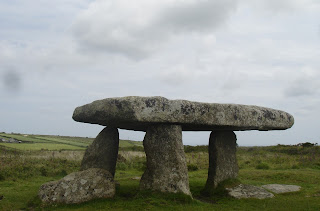This mind visit will be a pleasant memory of the moors plus friends and unexplained enigmatic stuff, no ghost stuff of course, just a rectangular megalithic enclosure that defies explanation sitting in a bowl of hills.
Where to start, we met at the Trippett stone circle and followed Roy in the car and we kept turning right, again and again through tiny Cornish lanes slowly circling the moor, until we came to a track way that reached up to a ridge. The cars bumped up this disintegrating road, just below the ridge was a scatter of rocks, and here we later found Bronze Age cists, and apparently settlement sites according to the map. Reaching the top of the ridge, we looked down to a small hamlet of three houses, crossing the small rocky beck that tumbled down, the cars were parked on a small green plateau, next to a land rover sporting the title Cornish Heritage and we were to meet the foreign tourists and their guide at the site later on. Even the vast empty spaces of the moor have life and visitors.
Walking uphill past the inevitable cattle, sheep and ponies with foals, we could see the grassy outlines of KAH in the distant a short walk of about 15 minutes. Climbing the stile and the first feeling is enclosure, you are surrounded for three quarters of the way by the rise of hills, and over in the distance behind a thick swathe of dark green forestry firs is the Stripples stone circle/henge monument which we did not see but is the only henge monument to be found in Cornwall at this time. The large untidy bank that surrounds the stones, causes many of them to keel over, and the walking path below the bank is difficult with great tussocks of grass and hidden stones. The theory is that this large enclosure was dug out maybe for water. (who knows) and the central area is boggy, reeds outline the boggy area and cotton grass was in 'flower' blowing gently in the wind, and just at the centre of this area a darker green patch of vegetation which meant deeper ground and water, the dogs drank from here.
A few words from the rather scant Wiki; The monument consists of fifty-six stones arranged in a rectangle with a bank of earth around them and measures approximately 20m by 47m. The interior fills with water and a contemporary ground level has not been established. It has suffered damage by cattle in the past and is now protected by a gated fence. It can be reached by footpaths east of St Breward.
There is a report by an archaeologist that gives the theory that in actual fact this is a medieval pound for the cattle up on the moors, and that two manors whose boundaries met here would have problems with straying cattle and they would be impounded, of course one would ask would it not be difficult with boggy ground and water to keep cattle there.
Feeling tells you that this is a ceremonial prehistoric monument, surrounded by stone circles on Bodmin Moor, there is a certain timelessness, stones cluster at the corners, there is a similar rectangular enclosure in Brittany, and apparently also at Lough Gur in Ireland, but until archaeological excavation proves the point one way or the other we cannot say.
Interesting link from 2010
Square structure at Carnac




















































